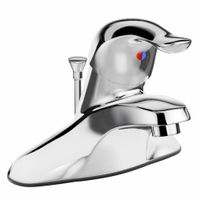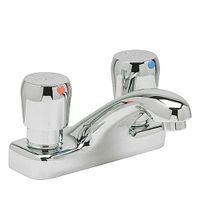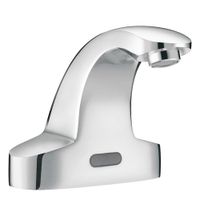Call +(254) 703 030 000 / 751 483 999 / 721 704 777
Frequently Asked Questions
What are the different types of bathroom faucets?
Bathroom faucets come in various types, each designed to suit different styles and functional needs:
1. **Single-Hole Faucets**: These combine the spout and mixing handles into a single unit, requiring only one drilled hole. They are ideal for smaller sinks and offer a modern, streamlined look.
2. **Centerset Faucets**: Designed for sinks with three holes, these faucets have a combined spout and handles on a single base unit, typically 4 inches apart. They are compact and suitable for small to medium-sized bathrooms.
3. **Widespread Faucets**: These have separate hot and cold water handles, with the spout in the middle. The components are individually mounted, usually 6 to 16 inches apart, offering a more customizable and elegant appearance.
4. **Wall-Mounted Faucets**: Installed on the wall above the sink, these faucets free up counter space and are often used with vessel sinks. They require plumbing within the wall, making them more complex to install.
5. **Vessel Sink Faucets**: Specifically designed for vessel sinks, these faucets are taller to accommodate the height of the sink bowl. They can be single-hole or wall-mounted.
6. **Bridge Faucets**: Featuring a classic design, bridge faucets have two handles connected by a horizontal bar, with the spout in the center. They are often used in traditional or vintage-style bathrooms.
7. **Touchless Faucets**: Equipped with motion sensors, these faucets turn on and off automatically, promoting hygiene and water conservation. They are ideal for modern bathrooms and public restrooms.
8. **Waterfall Faucets**: These faucets have a wide spout that creates a waterfall effect, adding a touch of luxury and relaxation to the bathroom.
Each type of faucet offers unique benefits and aesthetic appeal, allowing homeowners to choose based on their specific needs and design preferences.
How do sensor bathroom faucets work?
Sensor bathroom faucets operate using infrared technology. These faucets are equipped with an infrared sensor and an emitter. The emitter sends out an infrared light beam, which is invisible to the human eye. When a user places their hands in front of the faucet, the infrared light is reflected back to the sensor. The sensor detects this reflection and sends a signal to a solenoid valve, which is an electrically controlled valve.
The solenoid valve is responsible for controlling the flow of water. When the sensor sends the signal, the solenoid valve opens, allowing water to flow through the faucet. Once the user removes their hands, the infrared light is no longer reflected back to the sensor. The sensor then sends another signal to the solenoid valve to close, stopping the water flow.
These faucets are powered by either batteries or an electrical connection. Battery-powered models are more common in residential settings, while electrically powered ones are often used in commercial environments. Some advanced models also include features like temperature control, allowing users to preset the water temperature.
Sensor faucets are designed to conserve water and improve hygiene. They prevent the faucet from being left on unintentionally and reduce the need for users to touch the faucet handles, minimizing the spread of germs. Additionally, many models have a built-in timer that automatically shuts off the water after a certain period, further conserving water and preventing overflow.
What are the benefits of using a push-button metering bathroom faucet?
Push-button metering bathroom faucets offer several benefits:
1. **Water Conservation**: These faucets are designed to release a predetermined amount of water, reducing wastage. This feature is particularly beneficial in high-traffic areas, ensuring water is used efficiently.
2. **Cost Savings**: By minimizing water usage, push-button faucets can lead to significant savings on water bills. This is advantageous for both residential and commercial properties.
3. **Hygiene**: The push-button mechanism limits the need for users to touch the faucet, reducing the spread of germs and bacteria. This is especially important in public restrooms where hygiene is a priority.
4. **Durability**: These faucets are typically built to withstand frequent use, making them a durable choice for busy environments. Their robust construction ensures longevity and reduces the need for frequent replacements.
5. **Ease of Use**: The simple push-button operation is user-friendly, making it accessible for people of all ages and abilities, including children and the elderly.
6. **Consistent Performance**: The metering feature ensures a consistent flow and duration of water, providing a reliable user experience every time.
7. **Environmental Impact**: By conserving water, these faucets contribute to environmental sustainability, helping to preserve natural resources.
8. **Aesthetic Appeal**: Many push-button metering faucets come in sleek, modern designs that can enhance the look of any bathroom.
9. **Maintenance**: With fewer moving parts than traditional faucets, they often require less maintenance, reducing long-term upkeep costs.
10. **Compliance**: They often meet or exceed water efficiency standards and regulations, making them a compliant choice for new constructions and renovations.
How do I choose the right bathroom faucet for my sink?
To choose the right bathroom faucet for your sink, consider the following factors:
1. **Compatibility**: Ensure the faucet matches your sink's configuration. Common types include single-hole, centerset, widespread, and wall-mounted. Check the number of holes and their spacing.
2. **Style and Finish**: Select a style that complements your bathroom decor. Popular finishes include chrome, brushed nickel, oil-rubbed bronze, and matte black. Consider durability and ease of cleaning.
3. **Spout Height and Reach**: Choose a spout height and reach that fit your sink size and depth. Ensure it provides enough clearance for washing hands without splashing.
4. **Handle Type**: Decide between single-handle, double-handle, or touchless faucets. Single-handle offers convenience, while double-handle provides precise temperature control. Touchless is hygienic and modern.
5. **Material and Quality**: Opt for faucets made from durable materials like brass or stainless steel. Check for ceramic disc valves, which are more reliable and leak-resistant.
6. **Water Efficiency**: Look for WaterSense-labeled faucets, which use less water without sacrificing performance, helping to conserve water and reduce bills.
7. **Budget**: Set a budget and compare options within that range. Balance cost with quality and features.
8. **Brand Reputation and Warranty**: Choose reputable brands known for quality and customer service. Check warranty terms for peace of mind.
9. **Installation**: Consider ease of installation. Some faucets come with DIY-friendly features, while others may require professional installation.
10. **Additional Features**: Look for features like built-in water filters, temperature memory, or LED indicators if desired.
By evaluating these factors, you can select a bathroom faucet that meets your functional needs and aesthetic preferences.
What is the difference between single-handle and double-handle bathroom faucets?
Single-handle bathroom faucets feature one lever or knob that controls both the water temperature and flow. This design allows for easy, one-handed operation, making it convenient for quick adjustments. The single-handle design often results in a more streamlined and modern appearance, which can save space on the sink or countertop. Installation is typically simpler, requiring only one hole in the sink or countertop.
Double-handle bathroom faucets, on the other hand, have two separate handles—one for hot water and one for cold. This design allows for more precise control over water temperature, as users can adjust each handle independently to achieve the desired mix. Double-handle faucets often have a more traditional or classic look, which can complement certain bathroom styles. They usually require three holes for installation: one for each handle and one for the spout.
In summary, the main differences between single-handle and double-handle bathroom faucets lie in their design, ease of use, installation requirements, and aesthetic appeal. Single-handle faucets offer simplicity and a modern look, while double-handle faucets provide precise temperature control and a classic appearance.
How do I install a bathroom faucet?
1. **Turn Off Water Supply**: Shut off the water valves under the sink. If there are no valves, turn off the main water supply.
2. **Remove Old Faucet**: Disconnect the water supply lines using an adjustable wrench. Unscrew the nuts holding the faucet in place and remove it.
3. **Clean Surface**: Clean the sink surface to remove any old putty or debris.
4. **Install New Faucet**: Place the gasket or plumber’s putty on the sink holes. Insert the faucet through the holes. Secure it underneath with mounting nuts.
5. **Connect Water Supply Lines**: Attach the water supply lines to the faucet’s tailpieces. Tighten with a wrench, ensuring not to overtighten.
6. **Install Drain Assembly**: Apply plumber’s putty under the drain flange. Insert it into the sink drain hole. From underneath, attach the rubber gasket and nut. Tighten securely.
7. **Connect Pop-Up Assembly**: Attach the lift rod to the faucet. Connect the pivot rod to the drain tailpiece and the lift rod. Adjust for proper operation.
8. **Check for Leaks**: Turn on the water supply. Check all connections for leaks. Tighten as necessary.
9. **Test Faucet**: Turn on the faucet to ensure proper water flow and drainage.
10. **Seal Edges**: Apply silicone sealant around the base of the faucet if needed.
11. **Clean Up**: Wipe away any excess putty or sealant.
12. **Final Check**: Ensure everything is secure and functioning properly.
How do I fix a leaking bathroom faucet?
1. **Turn Off Water Supply**: Locate the shut-off valves under the sink and turn them clockwise to stop the water flow. If there are no valves, turn off the main water supply.
2. **Plug the Drain**: Use a sink plug or a rag to cover the drain. This prevents small parts from falling into it.
3. **Remove Faucet Handle**: Use a screwdriver or Allen wrench to remove the handle. You may need to pry off a decorative cap to access the screw.
4. **Take Out the Stem or Cartridge**: Depending on your faucet type (compression, ball, cartridge, or ceramic disk), you’ll need to remove the stem or cartridge. Use pliers or a wrench to unscrew the packing nut and pull out the stem or cartridge.
5. **Inspect and Replace Parts**: Check washers, O-rings, and seals for wear or damage. Replace any worn parts. For cartridge faucets, replace the entire cartridge if necessary.
6. **Reassemble the Faucet**: Reinsert the stem or cartridge and tighten the packing nut. Reattach the handle and secure it with the screw.
7. **Turn On Water Supply**: Slowly turn the water supply back on and check for leaks. If the faucet still leaks, ensure all parts are correctly installed and tightened.
8. **Test the Faucet**: Turn the faucet on and off to ensure it operates smoothly and no water leaks.
9. **Seek Professional Help**: If the leak persists, consider consulting a plumber for further diagnosis and repair.


